Interior Design Company Financial Model
This Interior Design Company Financial Model in Excel provides a structured framework to analyze the financial health and profitability of your company.
Financial Model for an Interior Design Company
Involves projecting the company’s financial performance over a specific period of 5 years. The model includes three core financial statements: the Income Statement, Cash Flow Statement, and Balance Sheet.
Income Statement
The Income Statement (or Profit and Loss Statement) shows the company’s revenues, expenses, and profitability over a specific period.
Key Components:
Revenue Streams:
Design Fees: Revenue from client projects (fixed fees, hourly rates, or percentage-based fees).
Product Sales: Revenue from selling furniture, decor, or other products.
Consulting Services: Revenue from advisory services or consultations.
Other Income: Revenue from referrals, partnerships, or affiliate marketing.
Cost of Goods Sold (COGS):
Direct costs associated with delivering services or selling products.
Examples: Cost of materials, subcontractor fees, shipping costs, and labor costs for designers.
Gross Profit:
Gross Profit = Revenue – COGS.
Represents the profitability of core business activities before overhead expenses.
Operating Expenses:
Fixed Costs: Rent, utilities, salaries (non-project-related staff), insurance, and software subscriptions.
Variable Costs: Marketing expenses, travel costs, and commissions.
Depreciation & Amortization: Allocation of the cost of long-term assets (e.g., office equipment, software licenses).
Operating Income (EBIT):
Operating Income = Gross Profit – Operating Expenses.
Measures profitability from core operations.
Net Income:
Net Income = Operating Income – Interest – Taxes.
Represents the company’s bottom-line profitability.
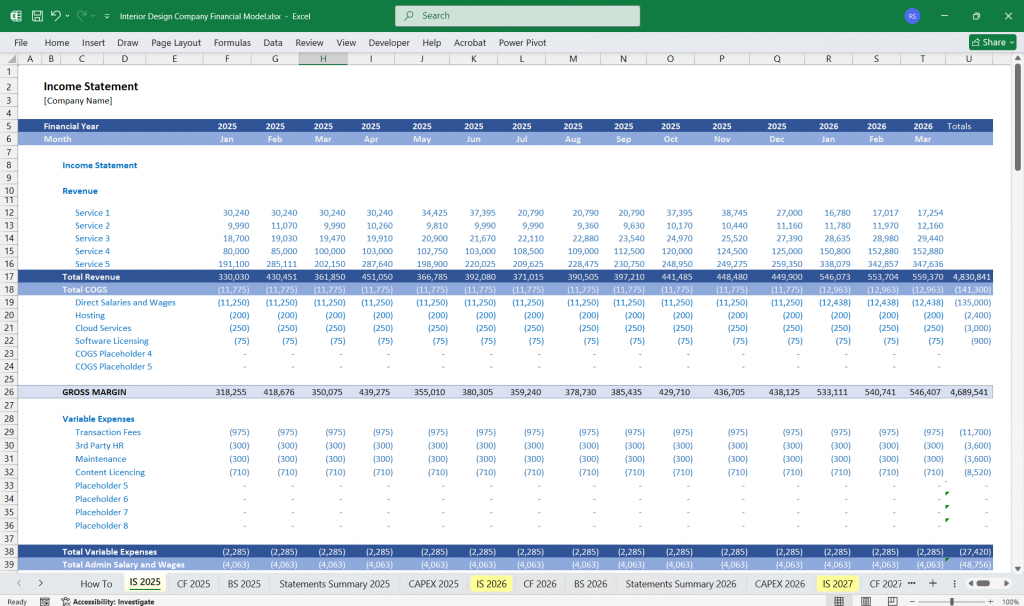
Interior Design Financial Model Cash Flow Statement
The Cash Flow Statement tracks the movement of cash in and out of the business, categorized into operating, investing, and financing activities.
Key Components:
Cash Flow from Operating Activities:
Cash Inflows: Payments from clients, deposits, and retainers.
Cash Outflows: Payments to suppliers, subcontractors, salaries, and operating expenses.
Net Operating Cash Flow: Cash generated from core business operations.
Cash Flow from Investing Activities:
Cash Outflows: Purchases of fixed assets (e.g., office furniture, computers, design software).
Cash Inflows: Proceeds from selling assets.
Net Investing Cash Flow: Cash used for or generated from investments.
Cash Flow from Financing Activities:
Cash Inflows: Loans, equity investments, or owner contributions.
Cash Outflows: Loan repayments, dividends, or owner withdrawals.
Net Financing Cash Flow: Cash generated from or used for financing.
Net Change in Cash:
Net Change in Cash = Net Operating Cash Flow + Net Investing Cash Flow + Net Financing Cash Flow.
Represents the overall change in the company’s cash position during the period.
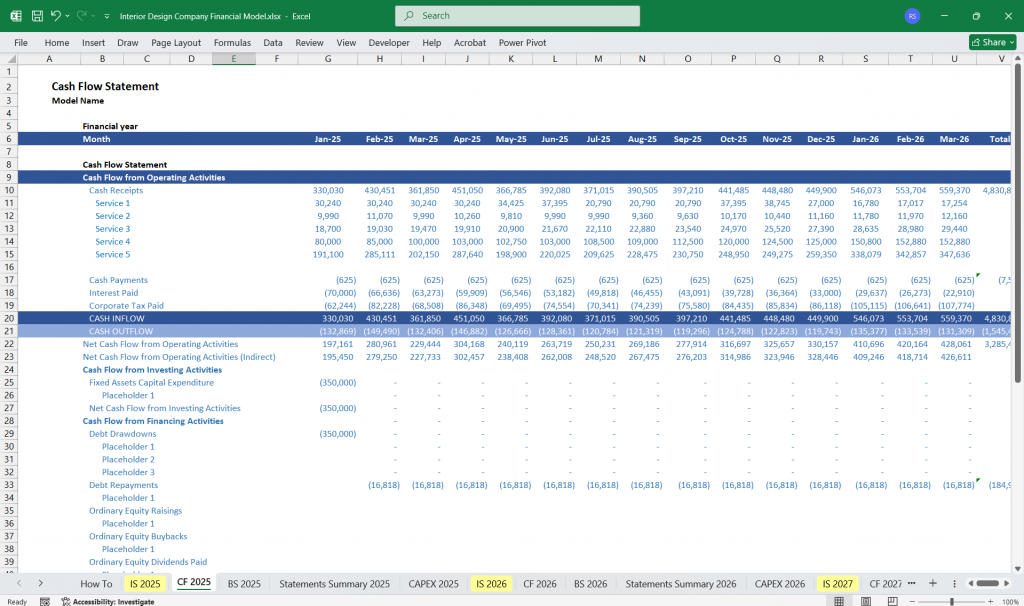
Interior Design Financial Model Balance Sheet
The Balance Sheet provides a snapshot of the company’s financial position at a specific point in time, showing assets, liabilities, and equity.
Key Components:
Assets:
Current Assets: Cash, accounts receivable (unpaid client invoices), inventory (e.g., furniture or decor), and prepaid expenses.
Fixed Assets: Office equipment, computers, software, and furniture (net of depreciation).
Other Assets: Deposits or long-term investments.
Liabilities:
Current Liabilities: Accounts payable (unpaid bills to suppliers), accrued expenses, and short-term loans.
Long-Term Liabilities: Bank loans or other long-term debt.
Equity:
Owner’s Equity: Initial capital invested by the owner(s) plus retained earnings (accumulated net income over time).
Retained Earnings: Net income retained in the business after dividends or withdrawals.
Balance Sheet Equation:
Assets = Liabilities + Equity.
Ensures the balance sheet remains balanced.
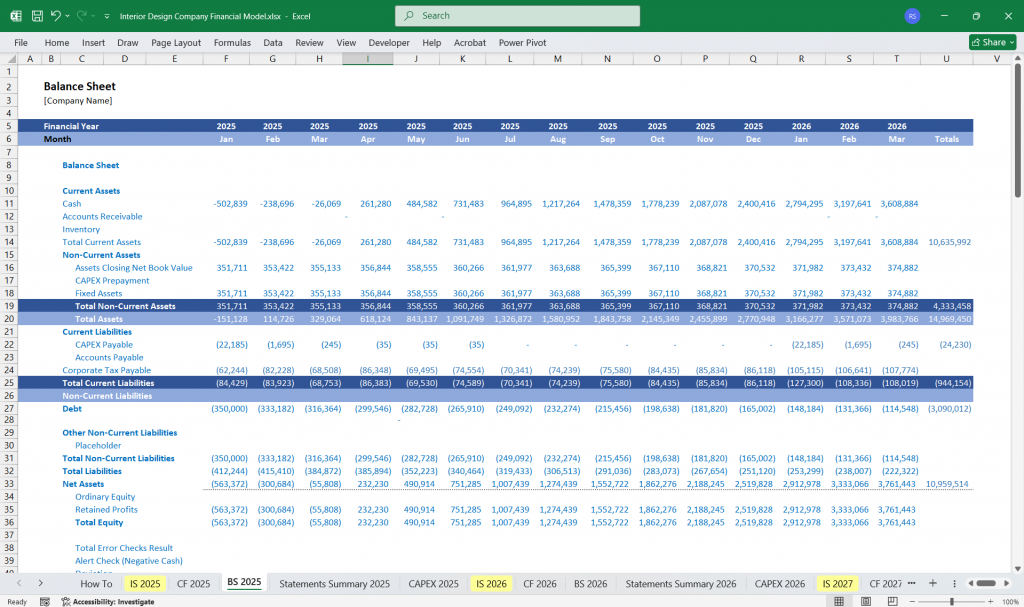
Assumptions and Drivers for an Interior Design Company
1. Design Client Base and Market Demand
Assumption: The company targets residential clients (70%) and commercial clients (30%), with a focus on mid-to-high-income households and businesses.
Drivers:
Demographic trends (e.g., urbanization, increasing disposable income).
Housing market conditions (e.g., new construction, home renovations).
Commercial real estate trends (e.g., office redesigns, retail spaces).
Impact: Understanding client needs and market demand helps tailor services and marketing efforts.
2. Design Service Offerings and Pricing
Assumption: The company offers full-service interior design, consultation-only services, and project management, with average project fees ranging from 5,000to5,000to50,000.
Drivers:
Scope of services (e.g., space planning, furniture selection, lighting design).
Pricing strategy (e.g., hourly rates, fixed fees, or percentage of project cost).
Upselling opportunities (e.g., custom furniture, art procurement).
Impact: Diversified service offerings and competitive pricing attract a wider range of clients.
3. Supplier and Design Vendor Relationships
Assumption: The company maintains partnerships with 10-15 reliable suppliers and vendors for furniture, fixtures, and materials.
Drivers:
Quality and cost of materials (e.g., sustainable, luxury, or budget options).
Lead times and reliability of suppliers.
Discounts or bulk purchase agreements.
Impact: Strong supplier relationships ensure timely project completion and cost efficiency.
4. Labor and Operational Design Costs
Assumption: The company employs 5 full-time designers and 2 administrative staff, with additional freelance contractors as needed.
Drivers:
Salaries, benefits, and training for employees.
Freelance or contract labor costs (e.g., architects, contractors).
Overhead costs (e.g., office rent, software subscriptions, marketing).
Impact: Managing labor and operational costs is essential for maintaining profitability.
5. Marketing and Design Branding
Assumption: The company allocates 10% of its annual revenue to marketing and branding efforts.
Drivers:
Digital marketing (e.g., social media, SEO, email campaigns).
Traditional marketing (e.g., print ads, networking events).
Brand positioning (e.g., luxury, eco-friendly, modern).
Impact: Effective marketing and branding attract new clients and build a strong reputation.
6. Project Timelines and Client Design Satisfaction
Assumption: The average project timeline is 3-6 months, with a client satisfaction rate of 90%.
Drivers:
Efficient project management and communication.
Quality of design and execution.
Handling of client feedback and revisions.
Impact: Timely project completion and high client satisfaction lead to repeat business and referrals.
Residential Design Services
Fees for full-home interior design projects.
Revenue from single-room redesigns.
Income from custom furniture and fixture design.
Earnings from consultation fees for DIY clients.
Commercial Design Services
Contracts for office space design and layout.
Revenue from retail store interior design.
Income from hospitality sector design projects (hotels, restaurants).
Earnings from designing public spaces like lobbies and lounges.
Renovation and Remodeling
Fees for kitchen and bathroom renovations.
Revenue from whole-house remodeling projects.
Income from historical property restorations.
Earnings from eco-friendly renovation services.
Design & Project Management
Charges for overseeing construction and design projects.
Revenue from coordinating with contractors and suppliers.
Income from timeline and budget management services.
Earnings from post-project evaluation and adjustments.
Custom Furniture Design
Sales of bespoke design furniture pieces.
Revenue from custom cabinetry and built-ins.
Income from personalized decor items.
Earnings from collaborations with local artisans.
Lighting Design
Fees for designing custom lighting solutions.
Revenue from selling designer lighting fixtures.
Income from smart home lighting system installations.
Earnings from energy-efficient lighting consultations.
Color Consulting
Charges for professional color scheme development.
Revenue from paint and finish selection services.
Income from design workshops on color theory and application.
Earnings from corporate color branding projects.
Space Planning
Fees for optimizing space utilization in homes.
Revenue from office space design efficiency projects.
Income from retail space and design layout optimization.
Earnings from virtual space planning services.
Sustainable Design
Revenue from eco-friendly material sourcing.
Income from green building certifications.
Earnings from sustainable furniture and decor sales.
Fees for consulting on sustainable design practices.
Virtual Design Services
Income from online interior design consultations.
Revenue from virtual room design packages.
Earnings from digital mood boards and design plans.
Fees for virtual design reality (VR) home tours.
Home Staging
Fees for staging homes for sale.
Revenue from rental furniture and decor for staging.
Income from consultation services for real estate agents.
Earnings from virtual home staging design services.
Event and Set Design
Contracts for designing event spaces (weddings, corporate events).
Revenue from theatrical and film set design.
Income from exhibition and trade show booth design.
Earnings from temporary installations and pop-ups.
Interior Decorating
Fees for selecting and arranging decor items.
Revenue from selling curated home decor design packages.
Income from seasonal decorating services.
Earnings from personalized decor consultations.
Feng Shui and Wellness Design
Charges for Feng Shui design consultations.
Revenue from wellness-focused interior design.
Income from designing meditation and yoga spaces.
Earnings from workshops on creating harmonious living spaces.
Textile and Upholstery Design Services
Revenue from custom design upholstery projects.
Income from selling designer fabrics and textiles.
Earnings from textile design and pattern creation.
Fees for upholstery repair and restoration.
Art Curation
Fees for selecting and placing art in homes and offices.
Revenue from selling original artwork and designer prints.
Income from organizing art exhibitions.
Earnings from partnerships with local design artists.
Acoustic Design
Charges for soundproofing and acoustic solutions.
Revenue from designing home theaters and music rooms.
Income from acoustic consulting for commercial spaces.
Earnings from selling acoustic panels and design materials.
Smart Home Integration
Fees for designing smart home systems.
Revenue from installing home automation technologies.
Income from consulting on IoT (Internet of Things) devices.
Earnings from maintenance and upgrade services.
Outdoor and Landscape Design
Revenue from designing outdoor living spaces.
Income from garden design and patio design projects.
Earnings from outdoor furniture design and decor sales.
Fees for integrating indoor and outdoor design elements.
Educational Services
Income from interior design courses and workshops.
Revenue from online tutorials and webinars.
Earnings from publishing design guides and eBooks.
Fees for one-on-one mentoring and coaching.
Key Considerations for Financial Planning:
Revenue Projections: Estimate income based on the number of design projects, average project fees, and client retention rates.
Cost Management: Monitor labor, supplier, and overhead costs to maintain profitability.
Client Acquisition: Invest in marketing and networking to attract new clients.
Quality Control: Ensure high standards of design and execution to build a strong reputation.
By understanding and managing these assumptions and drivers, an interior design company can optimize operations, reduce risks, and maximize profitability.

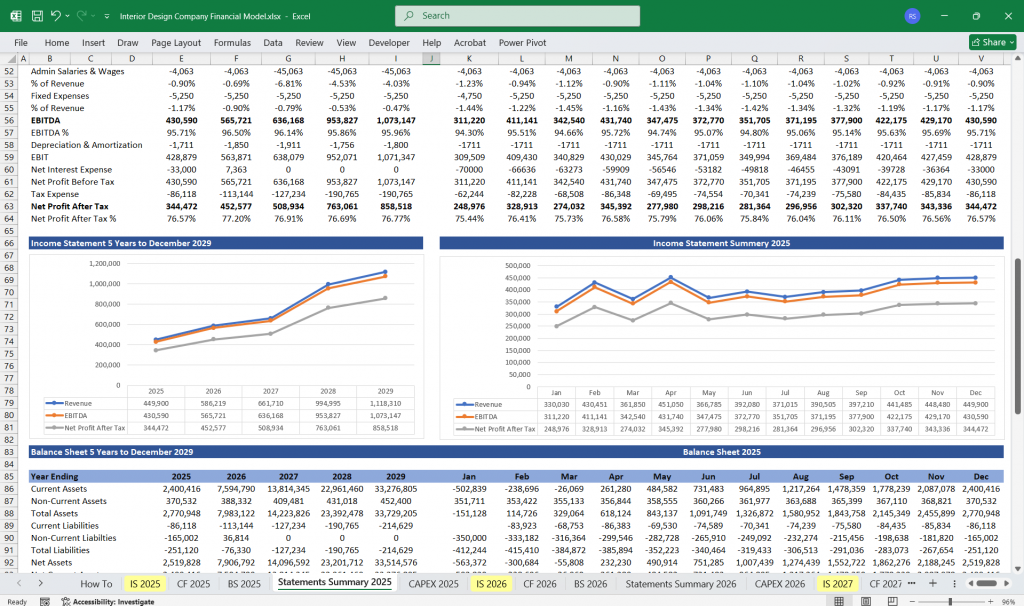
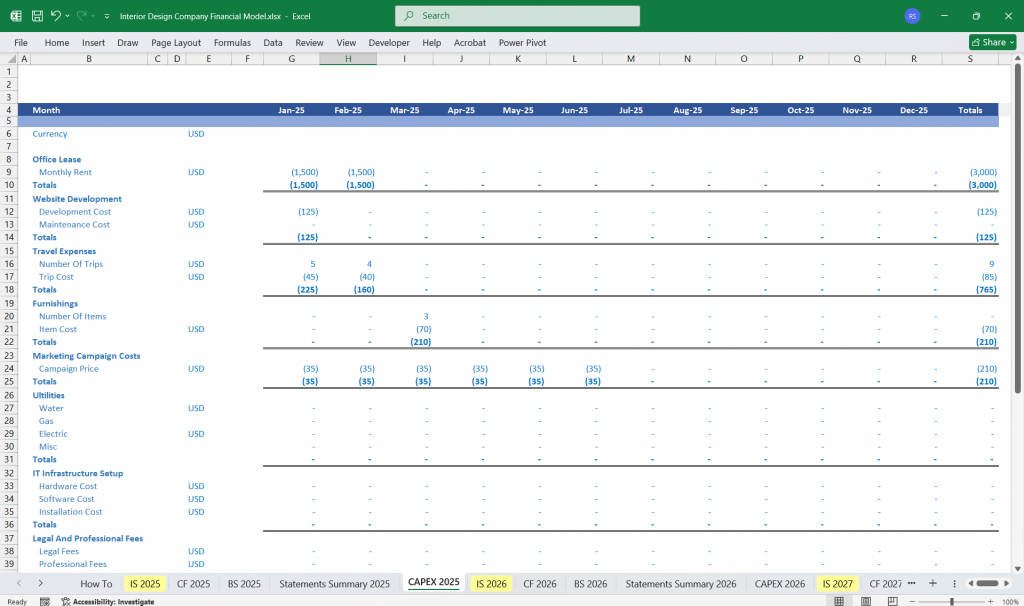
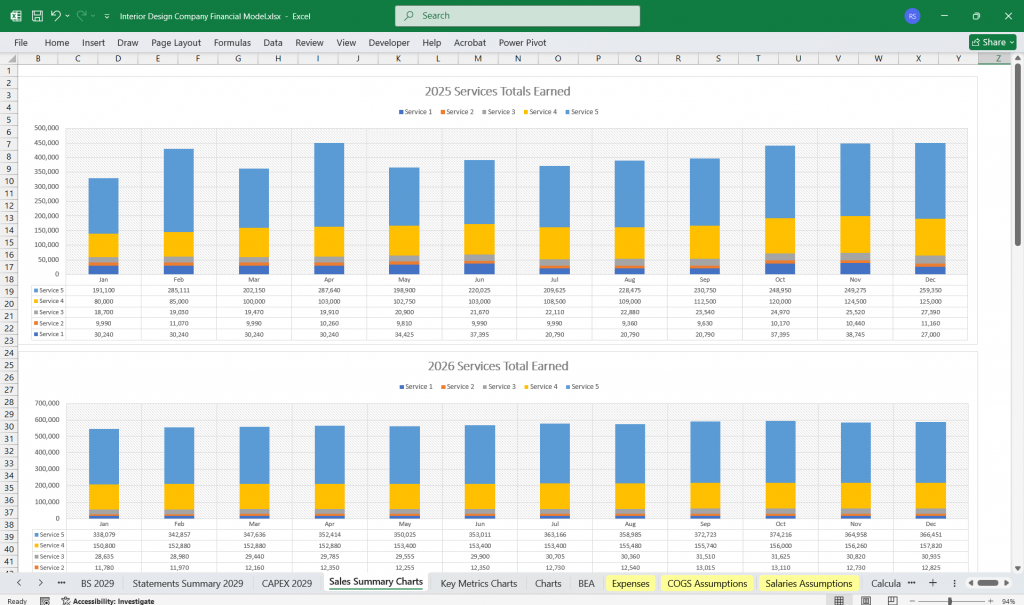
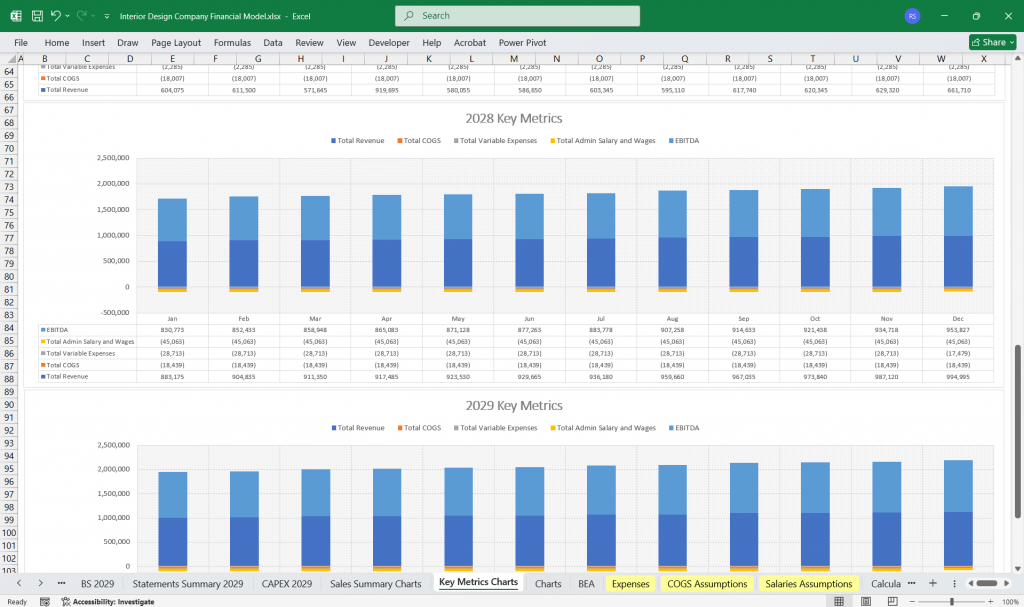
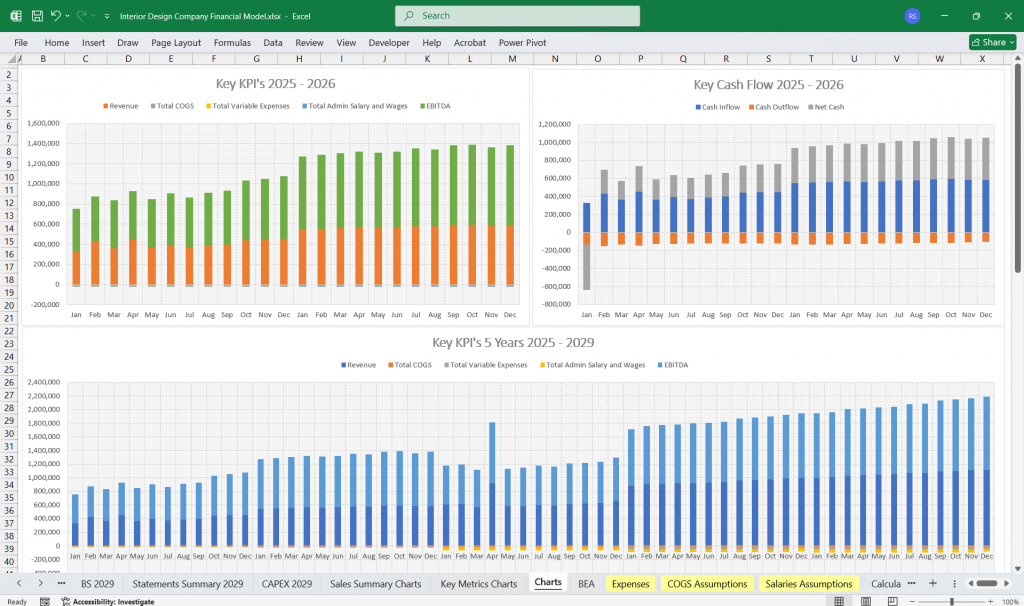
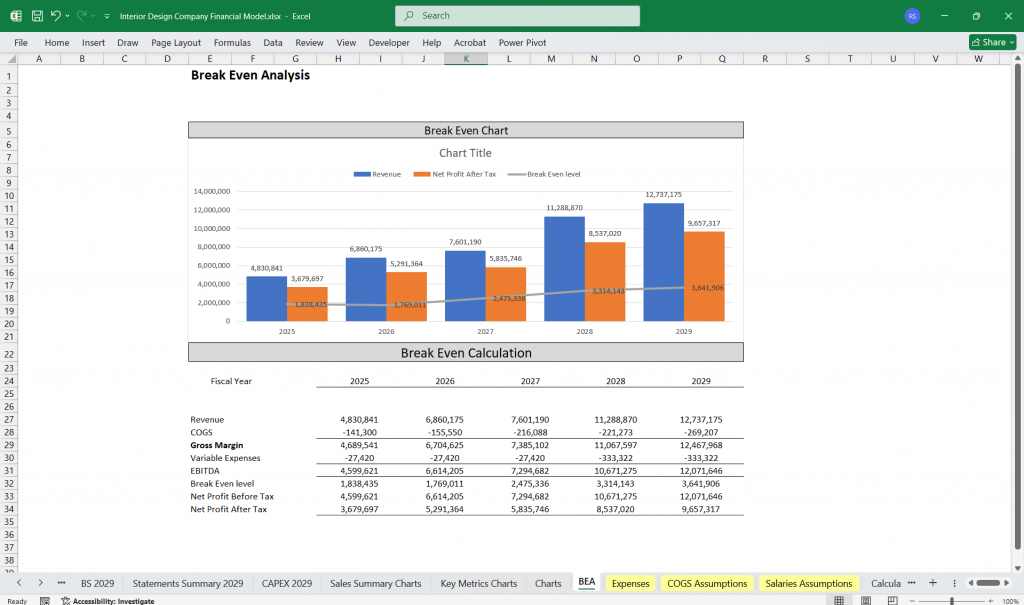
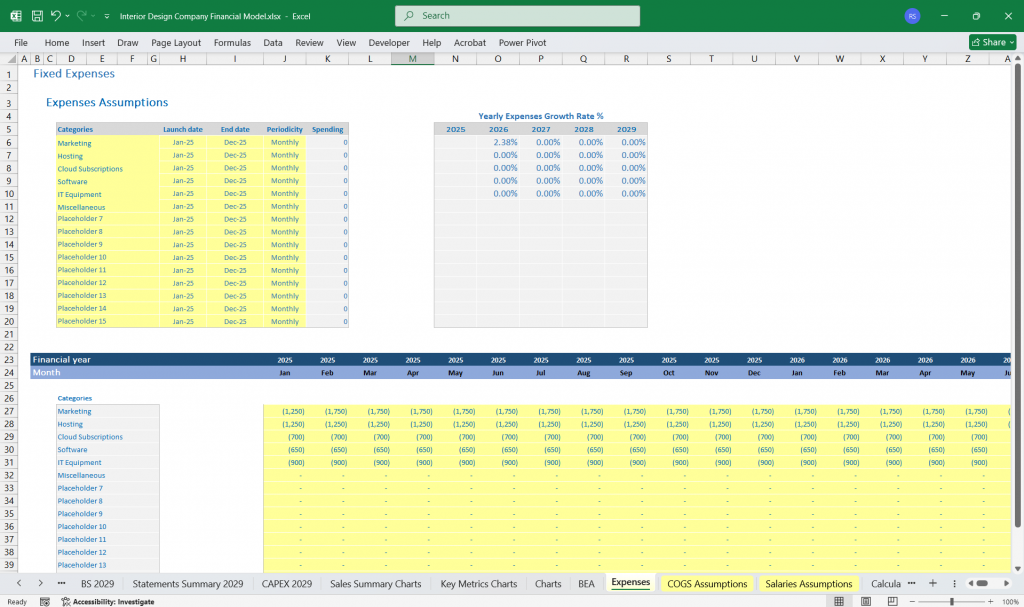
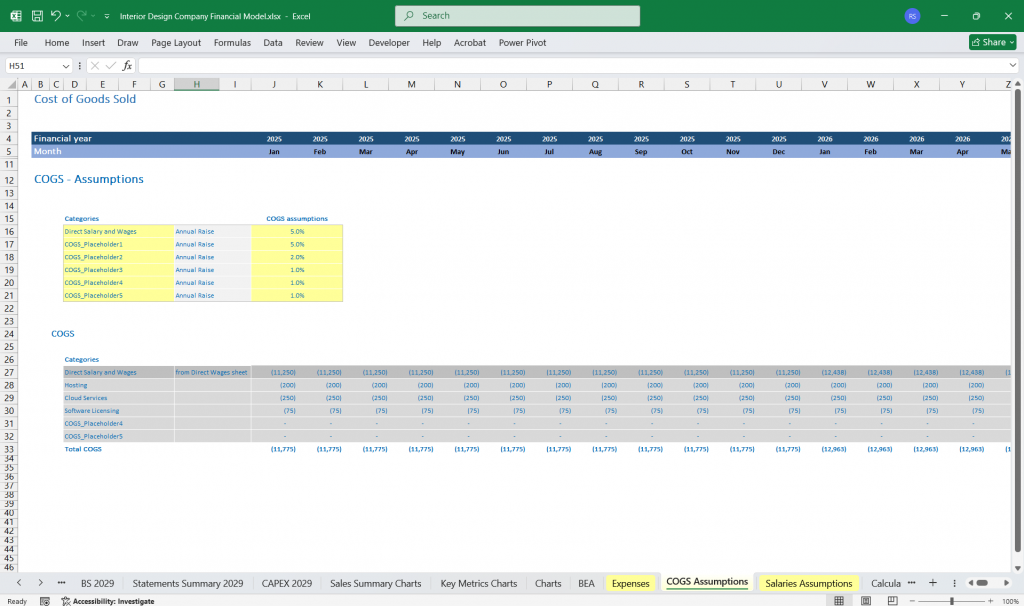
Final Notes on the Financial Model
- Scenario Analysis: Create best-case, base-case, and worst-case projections.
- Break-even Analysis: Determine sales volume required to cover fixed & variable costs.
- Sensitivity Analysis: Assess how changes in raw material costs, pricing, or demand impact profitability.
This Interior Design financial model provides a comprehensive view of the interior design company’s financial health and helps in making informed business decisions.
Download Available Immediately After Payment
